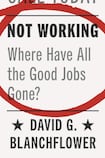
“The rich world is enjoying an unprecedented jobs boom,” proffered a recent headline in the Economist. Unemployment rates in the US, UK, Germany and Japan are plumbing depths unseen in decades. Robust job growth in the early months of 2019 sent the Irish unemployment rate below 5 per cent for the first time since 2007, leading some economists to suggest we are nearing “full employment”.
David G Blanchflower’s new tome, Not Working, may then appear to cut against the grain of the data. On the contrary, record low unemployment rates are the jumping-off point for this encyclopaedic survey of what ails our labour markets.
His central argument is that the unemployment rate is no longer the best indicator of how much slack there is in an economy because it ignores the extent to which people have given up the job search altogether (labour force participation) and part-timers want more hours (underemployment). This, he argues, is why wages are not growing as fast as would have been the case when unemployment rates were last so low.
But, because policymakers – and US and UK central bankers in particular – focus on the unemployment rate, they are overestimating the health of the economy, leading them to pre-emptively raise interest rates.
Economists are in thrall to elegant theory and sophisticated mathematical models, but lacking a commonsense understanding of how the real world works
This has real social costs. Those “left behind” increasingly rely on drugs and alcohol for solace, with depression and suicide on the rise. Life expectancy is falling in the US and UK. Politically, the lack of decent jobs laid the foundations for Brexit, and the rise of Donald Trump and fellow travellers.
Blanchflower is scathing in his appraisal of the economics profession, reserving his most acerbic assessment for Mervyn King, former Bank of England governor, and others of his former colleagues on the Bank’s Monetary Policy Committee. He critiques economists for being in thrall to elegant theory and sophisticated mathematical models, but lacking a commonsense understanding of how the real world works. Moreover, their models are based on historical data and their ideologies on historical experience, so they are fighting the last war.
Mileage may vary
By contrast, Blanchflower is a big believer in what he calls the Economics of Walking Around: gathering practical insights from the world around us. For example, tachometers on British delivery trucks showed that mileage was way down in early 2008, suggesting a recession was imminent, but economists weren’t paying attention. Counting cranes on the Dublin skyline would be another example closer to home.
Although it is not a central focus of Not Working, the Irish labour market shares important characteristics with the central characters: its US and UK counterparts. In contrast to much of continental Europe, it is relatively easy to hire and fire in Ireland, as is the case in the US and UK. Similarly, Ireland’s low unemployment rate probably flatters to deceive.
Declines in homeownership rates in recent decades suggest we may be able to drive unemployment and underemployment lower than we have ever seen before
According to CSO data, there are more than 100,000 people outside the labour force who could be attracted back in and the same number again are underemployed. There would need to be nearly 200,000 more people in jobs for the share of adults working to regain its 2007 peak. Wage growth is barely ahead of price inflation. Youth unemployment rates are still higher than the pre-2008 period, although record numbers are choosing further education over going straight into the workplace. This should boost their career earnings and reduce the risk of later unemployment spells. On the other hand, participation rates have already surpassed their 2007 peaks for all female age groups aged 25 and over.
One of the book’s most interesting insights for an Irish audience is into the relationship between home ownership and labour mobility. If fewer workers own their own homes, the argument goes, more will be willing to move to where the jobs are. Even if owning your own home has been central to the “American dream” – and its Irish and British equivalents – declines in homeownership rates in recent decades suggest we may be able to drive unemployment and underemployment lower than we have ever seen before.
Lack of imagination
While Blanchflower’s diagnosis is insightful, his prescriptions sometimes lack imagination. “If all you have is a hammer, everything looks like a nail” – and Blanchflower’s hammer is Keynesian demand stimulus: Central banks in advanced economies should maintain – or even further loosen – monetary policy, while governments should reverse austerity and avail of low interest rates to borrow to invest in infrastructure. Maybe this is necessary, but it is unlikely to be sufficient.
For an eminent labour economist, he has surprisingly little to say about reforms to labour market institutions or smoothing the transition from education to work, for example. While he laments the declining bargaining power of workers, due in part to the fall in trade union density and the rise of globalisation, he has little to recommend to reverse the trend. Other suggestions, such as his call to encourage philanthropy, are unlikely to move the needle.
Blanchflower presents a blizzard of statistics and marshals a wide academic literature to prosecute his case. Despite his folksy turn of phrase, however, a sometimes disjointed narrative and a focus on statistical minutiae won’t help the non-specialist discern the wood from the trees.
Victor Duggan is an economist based in Mexico City










